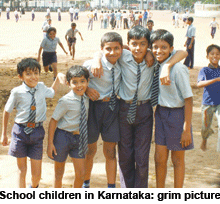Delhi: AIES-8 sneak peak
The provisional 8th All India Education Survey (AIES-8) — the census of all recognised schools in the country — released by the Delhi-based National Council of Educational Research & Training (NCERT) on January 23 with a reference date of September 30, 2009, doesn’t spring any surprises. It’s in line with academic estimates relating to growth in number of schools and student enrolment. According to the survey, the number of schools countrywide has grown from 1.04 million in 2002 to 1.30 million in 2009 — an increase of 27 percent. Conterminously student enrolment has increased by 13.67 percent and on September 30, 2009 almost 230 million (228,994,454) students were enroled in government recognised schools countrywide.
Like the DISE (District Information System on Education) which is a comprehensive school data collection exercise and includes details such as school, physical and ancillary facilities, teacher qualifications, teaching of sciences, availability of ICT equipment and internet, provisions for physically challenged children, mid-day meal scheme etc in primary education, AIES-8 also paints a grim picture of the school education system in India. The survey reveals that only 20 percent of schools offer children drinking water, 30 percent are bereft of usable toilet facilities and half don’t have playgrounds. AIES-8 confirms that the pervasive lack of usable toilets is the prime factor behind miserably poor girl children’s education with 42.25 percent dropping out before secondary school.
 The timing of AIES-8, which is essentially an audit of the national school infrastructure and evaluates its sufficiency for the child population, is apposite. March 31 is the final deadline for all schools countrywide to become fully compliant with the provisions of s. 19 of the Right to Free and Compulsory Education Act, 2009 (aka RTE Act) and Schedule of the Act. The RTE Act mandates that all elementary schools countrywide must meet nine specified infrastructure norms and provide for adequate teachers. The infrastructure norms include usable toilets, boundary wall, playgrounds, drinking water facilities, library, one teacher per classroom; school building, kitchen for preparing mid-day meals, teaching and sports equipment.
The timing of AIES-8, which is essentially an audit of the national school infrastructure and evaluates its sufficiency for the child population, is apposite. March 31 is the final deadline for all schools countrywide to become fully compliant with the provisions of s. 19 of the Right to Free and Compulsory Education Act, 2009 (aka RTE Act) and Schedule of the Act. The RTE Act mandates that all elementary schools countrywide must meet nine specified infrastructure norms and provide for adequate teachers. The infrastructure norms include usable toilets, boundary wall, playgrounds, drinking water facilities, library, one teacher per classroom; school building, kitchen for preparing mid-day meals, teaching and sports equipment.
According to the AIES-8 provisional report, between 2002-09 maximum growth rate was witnessed in the number of upper primary schools (49.15 percent), higher secondary schools (46.8 percent), secondary schools (28.95 percent) and primary schools (16.68 percent), in that order. The survey also reports a 30 percent increase in the number of teachers countrywide, and a 34 percent growth in higher secondary teachers, which has favourably impacted the teacher-pupil ratio which has declined from 1:42 to 1:32 nationally. Although in keeping with tradition, the survey is silent about quality improvement in school education, it’s disturbing that despite the impressive increase in the number of upper primary schools and decline in teacher-pupil ratios between 2002-09, learning outcomes as reported in Pratham’s ASER 2012 (see report from Maharashtra below) are deteriorating. It’s clinching proof that the quality of teachers being recruited is plunging.
“We are not satisfied with the 13.67 percent increase in school enrolment claimed by AIES-8. The survey doesn’t tell us how many children actually attend classes and for what duration. Moreover, civil society groups tracking the progress of the RTE Act in 4,000 schools countrywide indicate that only 7 percent of schools are RTE-compliant. The casual approach of the HRD ministry is evidenced by its failure to map the number of children between six-14 years, which was the prerequisite of determining the adequacy of schools. We are also told that the Central government is yet to release the second installment of its share towards funding the RTE Act, and is insisting that the states contribute their share first. This has bogged down implementation of the Act. AIES-8 statistics are impressive but unless the government machinery acts on its provisions, they will remain paper statistics,’’ says Ambarish Rai, convener of the RTE Forum, a network of more than 44 NGOs working towards universalisation of primary education.
Nevertheless, some anomalies not-withstanding, academics and educationists have welcomed AIES-8 data as authentic and accurate. They are almost unanimous that once the final report is out, it will form the basis of numerous interventions to reform India’s moribund school system.
In India’s chaotic school system defined by pervasive shortages, only hope is abundant.
K.V. Priya (Delhi)















Add comment